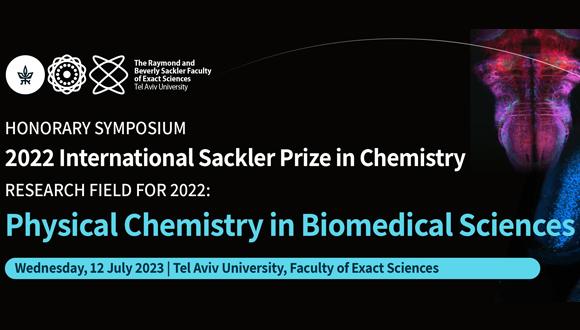Honorary Symposium - 2022 International Sackler Prize in Chemistry
Research Field for 2022: Physical Chemistry in Biomedical Sciences
10:00 – Gathering & Coffee
10:30 – Opening words and greetings
11:00 – Bringing bioelectricity to light, Prof. Adam E. Cohen, Depts. of Chemistry and Chemical Biology and of Physics, Harvard University
Abstract: Bioelectrical signaling is ubiquitous throughout life, from the firing of neurons to metabolism in bacteria. But voltage is not directly visible, and so many aspects of bioelectricity have remained mysterious. We engineered a protein from a Dead Sea microorganism to function as a fluorescent voltage indicator. This protein and associated optical tools opened a window into bioelectrical signaling in all its diversity.
11:50 – Coffee break
12:10 – Semiconductor-based biointerfaces for modulation and sensing across all length scales, Bozhi Tian, the University of Chicago
Abstract: In the evolving field of electronic and photonic biointerfaces, semiconductors have proven to be instrumental in facilitating the development of multifunctional devices such as sensors, modulators, and switches. Our research at the University of Chicago is directed toward devising non-genetic solutions for biological modulation and sensing across various length scales.
We have exploited light interaction with semiconductor materials and devices to devise a suite of biological modulation tools. These enable multiplexed, patterned stimulation, demonstrating great flexibility and spatial resolution while reducing excessive wiring. Through the exploration of the photothermal, photofaradic, and photocapacitive effects of nanostructured semiconductors, we have unveiled their potential to regulate neural, cardiac, and microbial activities at semiconductor-based biointerfaces. These biophysical or biomedical tools, distinct from traditional metal electrode-based devices, can offer solutions that circumvent the constraints inherent to conventional methodologies.
Our latest developments include a nanoporous/non-porous heterojunction, serving as a significant enhancement to the optical modulation biointerfaces. This heterojunction can facilitate non-genetic pulse stimulation of tissues in vivo, using a light intensity similar to optogenetics. Recent success with optical pacing in large animals symbolizes the precision and control we have in bioelectronic therapies. To delve deeper into the bioelectronics field, we're also studying the bioelectric properties of the subcellular components. Our initial findings on the use of electrically or photoelectrochemically produced extracellular vesicles and intracellular liquid condensates, for regenerative medicine in excitable tissues, will be discussed. Our aim is to transition these fundamental studies of modulation tools into clinical practices, thereby revolutionizing therapeutic strategies and enhancing patient outcomes.
Our exploration of bioelectronic sensing has resulted in several accomplishments. Previously, we have exemplified a field-effect transistor designed for intracellular delivery into single cells, thus facilitating the continuous monitoring of bioelectrical signals. We have also created nanoelectronics-innervated tissues, proficient in capturing electrical potentials within neural, cardiac, and vascular tissues in a three-dimensional framework. While offering a succinct overview of our transistor-based sensing systems, I will also present our latest advancement in semiconductor-based photocapacitive sensing, which employs the multifunctional architecture of multilayered heterojunctions.
At the end of this presentation, I will delineate our forthcoming research directions anticipated to serve as an impetus for advancements in the expansive field of biological modulation and sensing, particularly in translational applications.
13:00 - Light Lunch


